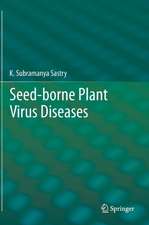Boophilus microplus: The Common Cattle Tick
Autor J. L. Nunez Traducere de H. Bailie Autor M. E. Munoz-Cobenas Traducere de C. Michelsohn Autor H. L. Moltedo Traducere de C. Parisen Limba Engleză Paperback – 6 dec 2011
Preț: 638.43 lei
Preț vechi: 751.10 lei
-15% Nou
Puncte Express: 958
Preț estimativ în valută:
122.17€ • 128.46$ • 100.94£
122.17€ • 128.46$ • 100.94£
Carte tipărită la comandă
Livrare economică 16-30 aprilie
Preluare comenzi: 021 569.72.76
Specificații
ISBN-13: 9783642702587
ISBN-10: 3642702589
Pagini: 224
Ilustrații: XIV, 204 p.
Dimensiuni: 170 x 244 x 12 mm
Greutate: 0.36 kg
Ediția:Softcover reprint of the original 1st ed. 1985
Editura: Springer Berlin, Heidelberg
Colecția Springer
Locul publicării:Berlin, Heidelberg, Germany
ISBN-10: 3642702589
Pagini: 224
Ilustrații: XIV, 204 p.
Dimensiuni: 170 x 244 x 12 mm
Greutate: 0.36 kg
Ediția:Softcover reprint of the original 1st ed. 1985
Editura: Springer Berlin, Heidelberg
Colecția Springer
Locul publicării:Berlin, Heidelberg, Germany
Public țintă
ResearchCuprins
I Introduction.- 1 Debilitating Action Exercised by a Hematophagus Parasite on a Host.- 2 Transmission of Diseases to Hematozoons.- 3 Losses Suffered by the Tanning Industry.- References.- II Taxonomy.- External Morphological Characteristics of Argasidae.- Internal Morphological Characteristics of Ixodidae and Argasidae.- References.- III Morphology and Physiology.- Capitulum.- Legs.- Dorsal Shield.- Digestive System.- Central Nervous System.- Circulatory System.- Respiratory System.- Reproductive System.- Cuticle (Exoskeleton).- References.- IV Life Cycle.- Free-Living Cycle.- Parasitic Life Cycle.- References.- V Therapeutics and Control.- Principles of the Control of Ticks.- Use of Chemical Products in the Control of Ticks.- Therapeutics.- Organophosphorous Compounds.- Commercial Formulations.- Carbamates.- New Acaricide Drugs.- Synthetic Pyrethroids.- Drugs of Systemic Action.- References.- VI Tick Control off the Host.- Grazing Treatments with Acaricides.- Biological Control by Means of Predators.- Sexual Sterilization of Adult Males.- Metabolic Alterations.- Hormones.- Use of Resistant Cattle.- References.- VII Host Resistance to Ticks.- 1 Resistance in Zebu (Bos indicus) and its Crosses.- 2 Resistance in European Cattle (Bos taurus).- The Inheritance of Resistance.- Conclusions.- References.- VIII Resistance.- Clinical Symptoms.- Mechanisms.- Arsenicals.- Chlorides.- Organophosphorous Compounds and Carbamates.- Synthetic Pyrethroids.- Evolution of Resistance After Relaxation of Chemical Pressure.- Genetics of Resistance.- Measuring Resistance.- References.





